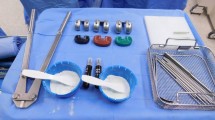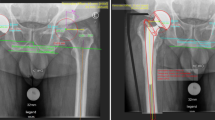Abstract
Objective
Mobile knee spacers can be utilized in the first stage of a two-stage exchange in periprosthetic joint infection or septic arthritis of the knee to prevent soft tissue contraction, enable local antibiotic elution, and improve patient mobility. Commercially made moulds enable the surgeon to prepare a reproducible spacer design and match the preparation of the arthroplasty, which will be carried out in a second step.
Indications
Periprosthetic joint infection of the knee and severe cases of septic arthritis of the knee with advanced destruction/infiltration of the cartilage.
Contraindications
Antibiotic resistance of the microbiological pathogen to available antibiotic agents, incompliant patient, large osseous defect preventing proper fixation, known allergy to polymethylmethacrylate (PMMA) or antibiotic, severe soft tissue damage with high ligament instability, especially deterioration of extensor mechanism and insufficient patella/quadricep tendon.
Surgical technique
After thorough debridement and removal of all foreign material, cutting blocks are used to shape femur and tibia to the implant design required. Using a silicone mould, PMMA with suitable antibiotics is moulded into the shape of the future implant. After polymerization, the implants are fixed onto the bone with additional PMMA without pressurize for the sake of easy removal.
Postoperative management
Partial weight bearing with no restriction of flexion/extension while spacer is in place; second stage reimplantation as soon as infection is controlled.
Results
In all, 22 cases were treated, mostly with a PMMA spacer containing gentamicin and vancomycin. Pathogens were detected in 13 of 22 cases (59%). We observed two complications (9%). Twenty of 22 patients (86%) were reimplanted with a new arthroplasty; 16 of the 20 patients remained revision-free and infection-free at the last follow-up (average time to follow-up 13 months, range 1–46 months). Average range of motion in flexion and extension at follow-up was 98°.
Zusammenfassung
Zielsetzung
Mobile Kniespacer können in der ersten Phase des zweizeitigen Austauschs bei periprothetischer Gelenkinfektion oder septischer Arthritis des Knies eingesetzt werden, um eine Weichteilkontraktion zu verhindern, eine lokale Antibiotikaelution zu ermöglichen und die Mobilität des Patienten zu verbessern. Kommerziell hergestellte Formen ermöglichen es dem Chirurgen, ein reproduzierbares Spacer-Design herzustellen und an die Präparation des später durchzuführenden Gelenkersatzes anzupassen.
Indikationen
Periprothetische Infektionen des Kniegelenks und schwere Fälle von septischer Arthritis des Knies mit fortgeschrittener Zerstörung/Infiltration des Knorpels.
Kontraindikationen
Resistenz des mikrobiologischen Erregers gegen verfügbare antibiotische Substanzen, nicht-gegebene Compliance des Patienten, großer Knochendefekt, der eine ordnungsgemäße Fixierung verhindert, bekannte Allergie gegen PMMA (Polymethylmethacrylat) oder Antibiotika, schwere Weichteilschädigung mit hoher Bandinstabilität, insbesondere Beeinträchtigung des Streckapparats und insuffiziente Patella‑/Quadrizepssehne.
Chirurgische Technik
Nach sorgfältigem Débridement und Entfernung sämtlichen Fremdmaterials werden Femur und Tibia mithilfe von Schnittblöcken an das benötigte Implantatdesign angepasst. Unter Verwendung einer Silikonform wird mit geeigneten Antibiotika versehenes PMMA in die Form des künftigen Implantats gebracht. Nach der Polymerisierung werden die Implantate mit zusätzlichem PMMA ohne vermehrten Druck auf dem Knochen fixiert, um eine leichte Entfernung zu ermöglichen.
Postoperative Behandlung
Teilbelastung der Extremität ohne Einschränkung der Flexion/Extension, solange der Spacer eingesetzt ist; Reimplantation in einer zweiten OP, sobald die Infektion konsolidiert ist.
Ergebnisse
Insgesamt wurden 22 Fälle behandelt, meist mit einem Gentamicin und Vancomycin enthaltenden PMMA-Spacer. In 13 von 22 Fällen (59%) wurden pathogene Erreger nachgewiesen. Es traten zwei Komplikationen auf (9%). 20 von 22 Patienten (86%) wurden mit einer neuen Endoprothese reimplantiert, 16 der 20 Patienten waren bei der letzten Kontrolluntersuchung (durchschnittliche Zeit: 13 Monate, Range 1-46) revisions- und infektionsfrei. Der durchschnittliche Bewegungsumfang in Flexion und Extension betrug bei der Kontrolluntersuchung 98°.









Similar content being viewed by others
References
Kurtz S et al (2007) Projections of primary and revision hip and knee arthroplasty in the United States from 2005 to 2030. J Bone Joint Surg Am 89:780–785
Kurtz SM et al (2010) Prosthetic joint infection risk after TKA in the medicare population. Clin Orthop Relat Res 468:52–56
Kapadia BH et al (2016) Periprosthetic joint infection. Lancet 387(10016):386–394
Author information
Authors and Affiliations
Corresponding author
Ethics declarations
Conflict of interest
M. Jaenisch, M. Babasiz, S. Ben Amar, E. Lück, M. Gathen, D.C. Wirtz and T.M. Randau declare that they have no competing interests.
For this article no studies with human participants or animals were performed by any of the authors. All studies mentioned were in accordance with the ethical standards indicated in each case.
Additional information
Editor
Maximilian Rudert, Würzburg
Illustrator
Rüdiger Himmelhan, Mannheim
Authors M. Jaenisch and M. Babasiz have contributed equally as first author to this publication.

Scan QR code & read article online
Rights and permissions
About this article
Cite this article
Jaenisch, M., Babasiz, M., Ben Amar, S. et al. Surgical technique and preliminary results of a moulded, mobile spacer for the treatment of periprosthetic joint infection of the knee. Oper Orthop Traumatol 35, 163–169 (2023). https://doi.org/10.1007/s00064-023-00803-z
Received:
Revised:
Accepted:
Published:
Issue Date:
DOI: https://doi.org/10.1007/s00064-023-00803-z




